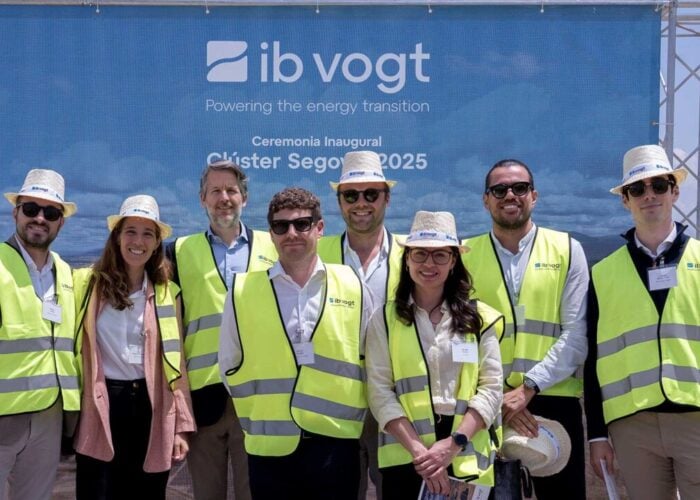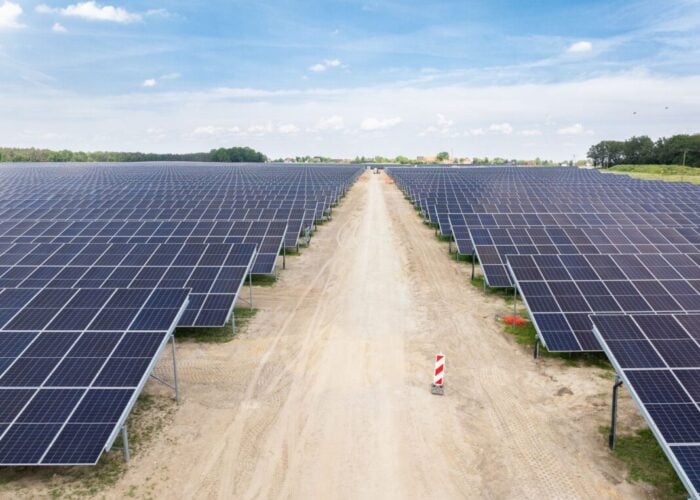US headquartered PV module encapsulant producer STR Holdings has secured a major new exclusive supply contract worth potentially 500MW per annum in volume sales through its majority shareholder, China-based PV project developer Zhenfa Energy Group. Financial details were not disclosed.
Zhenfa acquired a majority stake in STR late last year, an unusual move for a privately owned downstream PV project developer.
Unlock unlimited access for 12 whole months of distinctive global analysis
Photovoltaics International is now included.
- Regular insight and analysis of the industry’s biggest developments
- In-depth interviews with the industry’s leading figures
- Unlimited digital access to the PV Tech Power journal catalogue
- Unlimited digital access to the Photovoltaics International journal catalogue
- Access to more than 1,000 technical papers
- Discounts on Solar Media’s portfolio of events, in-person and virtual
STR had cited when then deal was announced that Zhenfa wanted to ensure that its PV module suppliers in China sourced the premium encapsulant products to ensure long-term module reliability and performance in the field, indicating that it had experienced issues in the field.
Zhenfa would specifically specify STR product with its module suppliers, providing a win-win for both companies.
Zhenfa was said to have developed around 1.3GW of PV power plant projects in China in 2013 and is believed to have currently taken that total to over 2GW, which did provide Zhenfa with the purchasing power to meet its goals.
However, STR noted in releasing fourth quarter and full-year financial results and in its earnings call that the 500MW exclusive supply deal was with a Chinese PV module manufacturer only described as ‘Huhui’ but an affiliate of Zhenfa.
However, in SEC filings, STR revealed that the module manufacturer was Zhangjiagang Huhui Segpv Co which often went simply by the name, SEG PV or Segpv and had exhibited in the past at major trade exhibitions such as Intersolar Europe.
The company had also been supplying modules into Europe and was included in the EU anti-dumping ruling of qualified importers that had agreed to the pricing floor.
Research by PV Tech reveals that in 2013, Zhenfa had made an investment in SEG PV to the degree that the module manufacturer was then under its control.
STR had not previously documented any association Zhenfa may have had with SEG PV.
SEG PV presentation material indicates that the company had a nameplate capacity of 300MW in 2012 and 400MW in 2013. By the end of 2014, capacity had expanded to 500MW.
However, the company had also shifted module production emphasis to OEM, primarily for around 10 to 15 other Chinese module producers, including the top 10 companies in China, according to presentation material and accounted for the majority of its business in the last two years.
The supply deal with sister company SEG PV is probably the biggest breakthrough STR had made in China, after spending several years trying to penetrate the market, which is dominated by Chinese producer, First PV and a 50% global market share.
STR had intensified efforts to break into the Chinese market after experiencing a period of rapid customer losses in Europe and the US due to bankruptcies, closures, exits and acquisitions, which was further compounded by its largest customer, First Solar completely switching to a rival supplier.
Historically, STR’s only major breakthrough in China had been securing Suntech Power Holdings as a customer, which in 2010 accounted for US$28 million in annual sales but had declined to only US$10 million per annum in 2012, ahead of Suntech’s bankruptcy.
The company also underwent major restructuring of its operations reducing manufacturing facilities and headcount, while establishing tolling production in China through ZheJiang FeiYu Photo-Electrical Science & Technology Co ahead of recently establishing its own production plant in China.
STR has also undertaken a major product and manufacturing redesign to eliminate paper liner from the encapsulant production process to reduce costs after coming under intensive pricing competition from producers already paperless and able to have overall lower production costs.
Previous to the exclusive supply deal with SEG PV, STR had undergone a number of qualification tests and factory audits by Chinese module producers but only one ‘major’ deal was sealed in 2014, said by the company to potentially generate around US$20 million per annum. STR has not revealed the customer nor provided equivalent megawatt volume of the deal.
Business rebound
After several years of diminishing revenue and cash, STR is on the cusp of rebuilding its revenue streams with new customers both in China and Malaysia.
In November last year, STR said it had expanded production at its plant in Malaysia to meet growing demand after the latest round of US anti-dumping duties on Chinese and Taiwanese made solar cells.
STR’s Malaysia facility had been earmarked to be ramped down as part of its restructuring efforts but the company had achieved certification with a potential new and ‘significant’ customer for the facility.
Since then, both Hanwha Q CELLS and JinkoSolar have announced major expansions of capacity in Malaysia and is the seen as the obvious relocation centre of choice for Chinese and Taiwanese producers wanting to competitively supply product to the booming US market as well as serve the EU market.
STR management said in their latest earnings call that a number of Chinese tier-1 module manufacturers as well as a major non-Chinese module manufacturer were conducting material qualification with STR in anticipation of using its Malaysian plant.
“We continue to believe that our Malaysian factory is well-positioned to benefit from the trend of manufacturing PV panels outside of China. Multiple Tier 1 Chinese module manufacturers as well as very significant non-Chinese module manufacturers, are currently in late-stage qualification of our materials with the aim of sourcing from our facility in Malaysia. We expect to see increased demand on our factories in Malaysia and China beginning in the second quarter of this year,” noted Robert Yorgensen, CEO of STR Holdings.
In China the involvement of Zhenfa and the appointment of Kong Weijie, a Zhenfa vice general manager that was appointed STR Sales Director for China in early March, 2015 has already had an impact on pushing potential sales.
Yorgensen added that, “Our cooperation with Zhenfa is already having a tangible and positive impact as 14 module manufacturers, introduced to us by Zhenfa, are currently qualifying our products and represent potential new sales revenue to STR of more than US$50 million on an annualized basis. By leveraging Zhenfa's help to also increase sales to our existing Chinese customer base, we believe there is a readily addressable market in China for annualized STR encapsulant sales of more than US$100 million and that this addressable market will continue to grow over time.”
Financial results
The timing could not be more crucial to STR as the company reported further losses and revenue decline for the fourth quarter of 2014.
STR reported a sequential encapsulant material volume decline in the quarter, said to be driven by European customers pushing orders out into 2015.
Quarterly sales were US$9.2 million, down 3% sequentially on a % volume decline and a 2% decrease in ASPs.
Implied shipments for the fourth quarter were said to equate to approximately 399MW, down from 410MW in the previous quarter.
Implied shipments for 2014 were said to equate to approximately 1.6GW.
Management noted in the earnings call that it had about 2GW of capacity in China and would be ramping to 4GW, including its tolling arrangement.
The company made a loss of US$5.7 million in the fourth quarter of 2014.
However, the expected rebound in its business fortunes is expected to result in a return to breakeven by the end of 2015.







